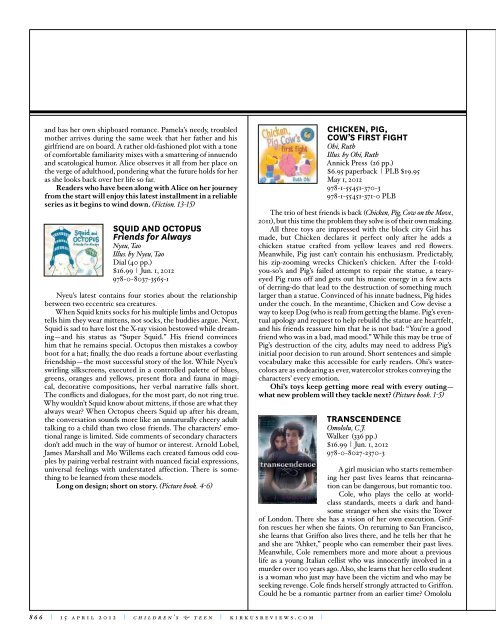nonfiction
nonfiction
nonfiction
You also want an ePaper? Increase the reach of your titles
YUMPU automatically turns print PDFs into web optimized ePapers that Google loves.
“Events churn to an utterly<br />
predictable confrontation that leaves the door open<br />
to the next volume in the planned trilogy.”<br />
from hemlock<br />
and has her own shipboard romance. Pamela’s needy, troubled<br />
mother arrives during the same week that her father and his<br />
girlfriend are on board. A rather old-fashioned plot with a tone<br />
of comfortable familiarity mixes with a smattering of innuendo<br />
and scatological humor. Alice observes it all from her place on<br />
the verge of adulthood, pondering what the future holds for her<br />
as she looks back over her life so far.<br />
Readers who have been along with Alice on her journey<br />
from the start will enjoy this latest installment in a reliable<br />
series as it begins to wind down. (Fiction. 13-15)<br />
SQUID AND OCTOPUS<br />
Friends for Always<br />
Nyeu, Tao<br />
Illus. by Nyeu, Tao<br />
Dial (40 pp.)<br />
$16.99 | Jun. 1, 2012<br />
978-0-8037-3565-1<br />
Nyeu’s latest contains four stories about the relationship<br />
between two eccentric sea creatures.<br />
When Squid knits socks for his multiple limbs and Octopus<br />
tells him they wear mittens, not socks, the buddies argue. Next,<br />
Squid is sad to have lost the X-ray vision bestowed while dreaming—and<br />
his status as “Super Squid.” His friend convinces<br />
him that he remains special. Octopus then mistakes a cowboy<br />
boot for a hat; finally, the duo reads a fortune about everlasting<br />
friendship—the most successful story of the lot. While Nyeu’s<br />
swirling silkscreens, executed in a controlled palette of blues,<br />
greens, oranges and yellows, present flora and fauna in magical,<br />
decorative compositions, her verbal narrative falls short.<br />
The conflicts and dialogues, for the most part, do not ring true.<br />
Why wouldn’t Squid know about mittens, if those are what they<br />
always wear When Octopus cheers Squid up after his dream,<br />
the conversation sounds more like an unnaturally cheery adult<br />
talking to a child than two close friends. The characters’ emotional<br />
range is limited. Side comments of secondary characters<br />
don’t add much in the way of humor or interest. Arnold Lobel,<br />
James Marshall and Mo Willems each created famous odd couples<br />
by pairing verbal restraint with nuanced facial expressions,<br />
universal feelings with understated affection. There is something<br />
to be learned from these models.<br />
Long on design; short on story. (Picture book. 4-6)<br />
CHICKEN, PIG,<br />
COW’S FIRST FIGHT<br />
Ohi, Ruth<br />
Illus. by Ohi, Ruth<br />
Annick Press (26 pp.)<br />
$6.95 paperback | PLB $19.95<br />
May 1, 2012<br />
978-1-55451-370-3<br />
978-1-55451-371-0 PLB<br />
The trio of best friends is back (Chicken, Pig, Cow on the Move,<br />
2011), but this time the problem they solve is of their own making.<br />
All three toys are impressed with the block city Girl has<br />
made, but Chicken declares it perfect only after he adds a<br />
chicken statue crafted from yellow leaves and red flowers.<br />
Meanwhile, Pig just can’t contain his enthusiasm. Predictably,<br />
his zip-zooming wrecks Chicken’s chicken. After the I-toldyou-so’s<br />
and Pig’s failed attempt to repair the statue, a tearyeyed<br />
Pig runs off and gets out his manic energy in a few acts<br />
of derring-do that lead to the destruction of something much<br />
larger than a statue. Convinced of his innate badness, Pig hides<br />
under the couch. In the meantime, Chicken and Cow devise a<br />
way to keep Dog (who is real) from getting the blame. Pig’s eventual<br />
apology and request to help rebuild the statue are heartfelt,<br />
and his friends reassure him that he is not bad: “You’re a good<br />
friend who was in a bad, mad mood.” While this may be true of<br />
Pig’s destruction of the city, adults may need to address Pig’s<br />
initial poor decision to run around. Short sentences and simple<br />
vocabulary make this accessible for early readers. Ohi’s watercolors<br />
are as endearing as ever, watercolor strokes conveying the<br />
characters’ every emotion.<br />
Ohi’s toys keep getting more real with every outing—<br />
what new problem will they tackle next (Picture book. 1-5)<br />
TRANSCENDENCE<br />
Omololu, C.J.<br />
Walker (336 pp.)<br />
$16.99 | Jun. 1, 2012<br />
978-0-8027-2370-3<br />
A girl musician who starts remembering<br />
her past lives learns that reincarnation<br />
can be dangerous, but romantic too.<br />
Cole, who plays the cello at worldclass<br />
standards, meets a dark and handsome<br />
stranger when she visits the Tower<br />
of London. There she has a vision of her own execution. Griffon<br />
rescues her when she faints. On returning to San Francisco,<br />
she learns that Griffon also lives there, and he tells her that he<br />
and she are “Ahket,” people who can remember their past lives.<br />
Meanwhile, Cole remembers more and more about a previous<br />
life as a young Italian cellist who was innocently involved in a<br />
murder over 100 years ago. Also, she learns that her cello student<br />
is a woman who just may have been the victim and who may be<br />
seeking revenge. Cole finds herself strongly attracted to Griffon.<br />
Could he be a romantic partner from an earlier time Omololu<br />
moves the action along, revealing her plot, narrating the past-life<br />
memories in italics and inserting intriguing clues into those episodes.<br />
The classical-music motif is a welcome addition to the plot,<br />
and the reincarnation theme stands out as a nice break from the<br />
usual paranormal subject matter. That Griffon is biracial, both<br />
indicated on the cover and revealed in the text, promises another<br />
nice break, but there is no textual follow-up.<br />
Overall, nicely done. (Paranormal romance. 12 & up)<br />
THE TIPTOE GUIDE TO<br />
TRACKING MERMAIDS<br />
Paquette, Ammi-Joan<br />
Illus. by Letourneau, Marie<br />
Tanglewood Press (32 pp.)<br />
$16.95 | May 1, 2012<br />
978-1-933718-59-0<br />
This second Tiptoe Guide (The Tiptoe Guide to Tracking Fairies,<br />
2010) has readers scouring the seashore for mermaids and<br />
imagining what their lives must be like.<br />
Not a story, but not a guidebook in the traditional sense<br />
either, this is more of a fits-and-starts foray into imagination<br />
that may leave many of its readers behind. Listen to a conch<br />
shell’s secrets, search a tidal pool for evidence of baby mermaids,<br />
imagine shells as mermaid jewelry, sand dollars as money and<br />
ocean plants as food, with crabs scrounging the leftovers. But<br />
the author goes beyond readers’ reach, as the mermaids play<br />
with dolphins, swim amid the coral and carry out their daily<br />
activities (primping, napping, shopping) on the ocean floor.<br />
While Paquette’s first capitalized on the popularity of fairy<br />
houses and the easy accessibility of most to the great outdoors,<br />
this latest narrows its readership by focusing on the ocean. It<br />
further disappoints this limited audience by highlighting beachcombing<br />
finds that are relatively rare, if not geographically<br />
impossible: perfect sand dollars and conch shells, ocean plants,<br />
tide pools—not to mention the warm-enough-for-a-bathingsuit<br />
but nonetheless deserted, beach. Letourneau layers her fanciful<br />
watercolor mermaids atop beautiful photographs, which<br />
gives a jarring feel to the artwork. Further, when the text asks<br />
readers, “Can you see any mermaids anywhere” she makes no<br />
effort at hiding them.<br />
The glittery cover and promise of mermaids may<br />
attract readers initially, but there is little here to lure them<br />
for repeated readings. (Picture book. 4-7)<br />
HEMLOCK<br />
Peacock, Kathleen<br />
Katherine Tegen/HarperCollins<br />
(416 pp.)<br />
$17.99 | May 8, 2012<br />
978-0-06-204865-3<br />
Ever since the white werewolf killed<br />
Mackenzie’s best friend, Amy, she’s been<br />
having nightmares. Amy’s boyfriend, Jason,<br />
has gone off the deep end. And their other<br />
friend, Kyle, has distanced himself.<br />
The Trackers, an anti-werewolf vigilante group, have come to<br />
Hemlock to round up anyone with Lupine Syndrome to be permanently<br />
interned in a government-run “rehabilitation camp.”<br />
You’d think Mackenzie would be behind this, but one of the few<br />
caring adults in her peripatetic youth with a no-good father was<br />
a closeted werewolf who had never hurt anyone but was rounded<br />
up and interned anyway. Peacock makes sure readers understand<br />
the symbolism; narrator Mackenzie actively reflects on the parallels<br />
between the werewolf hunt and war propaganda. But because<br />
this is a teen paranormal romance, the dominant plot is, surprise,<br />
a love triangle. Kyle, who Mackenzie and readers learn fairly early<br />
on is a werewolf, is in love with Mackenzie. So is the tortured Jason,<br />
who has joined the Trackers. As Mackenzie says to herself, “It was<br />
official: my life belonged on the CW.” It’s this ironic self-awareness<br />
that keeps the book at all palatable. Events churn to an utterly predictable<br />
confrontation that leaves the door open to the next volume<br />
in the planned trilogy.<br />
Mildly interesting ideas are obscured by all the necessary<br />
ingredients of the genre. (Paranormal romance. 14 & up)<br />
COCK-A-DOODLE WHO<br />
Perrin, Martine<br />
Translated by Kossnar, Elizabeth<br />
Illus. by Perrin, Martine<br />
Whitman (40 pp.)<br />
$12.99 | May 1, 2012<br />
978-0-8075-1107-7<br />
Die-cuts and a rhyming question-and-answer format showcase<br />
animals and patterns.<br />
Two different but similar patterns are used in this puzzle that<br />
depends on reveals. A die-cut animal shape is shown against an<br />
inappropriate pattern, and a question is posed. “Mooing cow, for<br />
whom do you wait” (The cow has a black-and-white–flowered<br />
hide.) After the page turn, the animal has its proper pattern and<br />
the new image answers the original question. “This maid stepping<br />
with a very quick gait.” (The milkmaid wears a flowered<br />
dress; the Holstein now has the usual black-and-white coloring.)<br />
The cow, duck, snail, sheep, ladybugs, trout, fox and rooster are<br />
presented as a farm animal collection, but they make an unusual<br />
one. The couplets, translated from the original French, have<br />
end rhyme, but limping rhythm makes them difficult to read<br />
aloud. Two of Perrin’s previous books have been published here<br />
as board books (Look Who’s There! and What Do You See, 2011)<br />
866 | 15 april 2012 | children’s & teen | kirkusreviews.com |<br />
| kirkusreviews.com | children’s & teen | 15 april 2012 | 867






